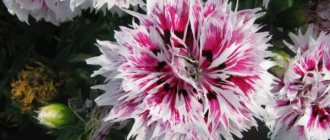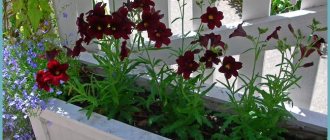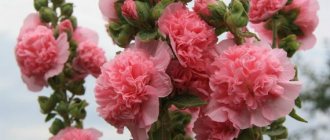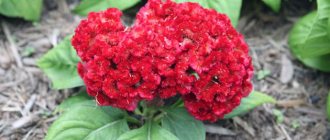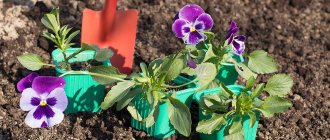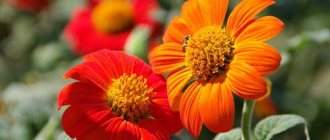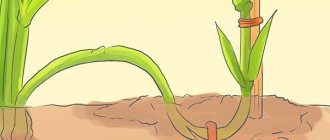Author: Natalya Category: Garden plants Published: February 15, 2019Republished: February 15, 2019Last edits: January 13, 2021
- When to sow
- Growing conditions
Turkish carnation, or bearded carnation (lat. Dianthus barbatus) is a plant of the Carnation genus of the Carnation family. The generic name of the plant is translated from Greek as “flower of Zeus” or “divine flower”, and this carnation is called bearded for the presence of bracts with ciliated edges. Turkish clove is originally from Southern Europe. It grows on river sands, in groves, deciduous forests, meadows and rocks. The plant has been in cultivation since 1573, and today Turkish cloves can be found in almost every garden. It is used to create alpine slides, flower beds, borders and even as a ground cover plant.
Planting and caring for Turkish carnation
- Flowering: from late June to late July.
- Planting: sowing seeds for seedlings - at the end of March or early April, planting seedlings in the ground - in the second half of May. Sowing seeds directly into the ground - at the end of May or early June, as well as in October, but before winter only dry seeds are sown.
- Lighting: bright sunlight.
- Soil: fertile, sandy loam or loamy.
- Watering: 2 times a week, with a consumption of 12-15 liters of water per 1 m² of area. In hot and dry summers you will have to water more often.
- Feeding: three times per season: when the seedlings grow to 10-12 cm, at the stage of formation of the first buds and during flowering. Both mineral and organic solutions can be used.
- Reproduction: seed - seedlings and non-seedlings.
- Pests: mole crickets and earwigs.
- Diseases: fusarium, rust and viral mottling.
Read more about growing Turkish cloves below.
Features of care
Despite the fact that Turkish carnation flowers are considered unpretentious, the plant cannot be completely ignored. In hot, dry weather, moderate watering is required in the evenings. Periodically it is necessary to loosen the soil and remove weeds. At the same time, you should not overdo it with water, otherwise stagnation will occur and the roots may rot. Also, do not allow water to get on the flowers themselves during watering, because this can cause sunburn.
Related article:
Turkish cloves: 9 growing features
Feeding is required. The first, using a complex mineral fertilizer, is applied at a time when the plant height reaches 10 cm. If the carnation is planted in the fall in October, it should be fed with a complex phosphorus fertilizer. A second feeding is required at the budding stage.
If you cut off the faded buds, the plant can bloom a second time in the season. The main thing is to cut them carefully and not tear them off, damaging the stem and leaves.
By following these simple rules, you can grow luxurious flowers that will decorate your balcony, garden plot, flower beds, and interior for years. After all, flowers can be cut and assembled into a beautiful bouquet.
Botanical description
Turkish clove is a herbaceous perennial grown in a biennial crop. It has straight, strong, knotty stems 30-75 cm high, glabrous, sessile lanceolate opposite leaves, green or blue-green with a reddish tint, and numerous fragrant, double, semi-double or single flowers with a diameter of 1.5 to 3 cm in various shades of white , red, pink, cream - one-color, two-color, variegated, velvety, with a border or eye. The flowers are collected in a corymbose inflorescence up to 12 cm in diameter, which opens in the second year of life and blooms for a month from the end of June. In the first year, Turkish carnation forms only a rosette of leaves. The fruit of the plant is a capsule with black flat seeds that ripen by August and remain viable for 3 to 5 years. Turkish carnations are grown not only for landscaping, but also for cutting: its inflorescences stand in water for up to two weeks.
Planting and maintenance conditions
It doesn’t matter how you plant carnations (seeds or seedlings), the planting conditions will be approximately the same. Those who are planning to plant carnations in central Russia need to keep in mind that they will need good lighting, fertile soil and regular watering (especially if the spring and summer were dry). A two-year crop is usually grown in such conditions, since this is the best option for a climate of this kind.
Choice of location and lighting
Turkish carnation loves sunny areas, but will not refuse garden partial shade. Since growing this plant requires fertile soil, planting seedlings in swampy soil or loam is not recommended. Such waterlogging of the plant’s root system will lead to the appearance of fungus and rot. Areas under bushes and trees should be avoided.
Temperature
Carnation is resistant to low temperatures, so it will not be afraid of spring or autumn frosts. If you plant seeds, it is important to choose April for this. At this time, the earth will already be warm enough. You can, of course, plant the plant in winter, but this is more risky. Non-frost-resistant varieties should be protected from such temperature changes and planted in seedlings. If there is a danger of frost, you can cover the flower beds with spruce for some time.
Watering
Perennial varieties of carnations do not like too much moisture, so they need to be watered abundantly only in particularly dry and hot seasons. Spraying is also not required; it is important to avoid getting water on the buds during watering.
Priming
The soil for planting must have a loose structure. It should be fertile, richly flavored. When digging, you should add humus, compost and a handful of ash to the soil. As practice shows, carnations take root best on sandy loam soil with neutral or slightly alkaline acidity. Be sure to remove all weeds and roots from the flowerbed before planting the plant.
Growing Turkish cloves from seeds
How to sow seeds
If you decide to grow Turkish cloves in seedlings, then sowing is carried out in March or early April in a substrate previously disinfected with a dark pink solution of potassium permanganate. The substrate is prepared from sand and leaf humus in equal parts. Instead of sand, you can use vermiculite. Boxes or containers can be used as containers, which must be washed with hot water and soda before use. A drainage layer is placed at the bottom of the container, and a wet substrate is placed on top.
Turkish clove seeds are sown to a depth of 1 cm, placing them at a distance of 2-3 cm from each other. The crops are covered with loose white paper and kept at a temperature of 16-18 ºC, from time to time moistening the substrate from a spray bottle with water at room temperature.
- Tips for caring for homemade geraniums
Seedling care
As soon as the seedlings appear, the crops are moved as close to the light as possible, and the temperature is lowered by 2-3 degrees so that the seedlings do not stretch out. It is likely that you will have to provide additional lighting for the seedlings, since the plants need a lot of light. At the stage of formation of the second pair of true leaves, the seedlings dive into peat pots with a soil mixture of the same composition in which you sowed the seeds. Caring for Turkish carnation seedlings consists of regular watering and careful loosening of the substrate around the seedlings.
Seedlings are planted in open ground in the second half of May, when warm weather sets in, but before planting, Turkish carnation seedlings must undergo hardening procedures: the crops are taken out into the open air every day, gradually increasing the duration of the session. At first half an hour is enough, but in two weeks the Turkish carnation from seeds should get used to the new environment so much that you can safely plant it in a flowerbed.
Sowing in open ground
When to plant garden cloves with seeds, each gardener decides for himself. This can be done at different times of the year - in Vienna, summer or autumn. The most optimal planting dates are the end of April, June or the beginning of autumn before the onset of frost. In any case, several preparatory measures are carried out before planting the seed material in the ground.
- They dig up a bed or flower bed, break up lumps, loosen and remove weeds.
- Water the ground with a watering can.
- Make shallow furrows, scatter the seeds at a distance of 2 cm, deepening them by 1 cm. The seeds can be pre-soaked before planting, but this is usually not required.
- Sprinkle with earth.
When planting seeds in open ground in autumn, the planting material is not soaked, and the furrows are left dry and not watered. When cold weather sets in, the flowerbed is covered with spruce branches or hay.
Sowing Turkish cloves in the ground
When to sow
Turkish carnation flowers can be sown directly in the garden, bypassing the stage of growing seedlings. When to plant Turkish cloves in the ground? At the end of May or at the beginning of June, when the soil has warmed up and the threat of return frosts has passed. You can sow Turkish clove seeds in October, but do not forget that any autumn sowing should be done with dry seeds, and the soil should also be dry. In the fall, crops are mulched with peat or sawdust, and in the spring the mulch is removed.
How to plant
Choose a sunny area for the plant with fertile soil, preferably sandy loam or loamy soil. One to two weeks before sowing, the soil on the site should be dug up to a depth of 20-25 cm with the simultaneous application of compost or humus and wood ash at the rate of 6-8 kg of organic matter and 200-300 g of ash per 1 m² of site. You can also add mineral fertilizers: a tablespoon of Nitrophoska and a teaspoon of Agricola for flowering plants for the same unit area. After digging, the area is covered with plastic film.
When the time comes to sow cloves, the film is removed, grooves 1-1.5 cm deep are made in the soil at a distance of 15 cm from each other, they are well shed with water, and then the seeds are laid out in them in increments of 2-3 cm. After planting the seeds, the surface lightly compact and cover with non-woven material until emergence.
How and when to pluck Turkish carnation seedlings
The most suitable time for picking seedlings of Turkish carnation occurs at the development stage, when the plants grow 2-3 true leaves. You can replant in the same soil, but it is advisable to use individual containers. If you still want to plant in a common box, then the distance between plants in such a container should be at least 7 centimeters.
It is necessary to pick seedlings of Turkish carnation according to the following rules:
- Water the plants in advance so that the water has time to be absorbed.
- Fill new containers with soil and make holes.
- Carefully pick up the seedlings, transfer them to the hole along with a lump of earth, and bury the cotyledon leaves.
- Fill the hole with soil, lightly compact the soil and water.
Advice! It is recommended to carry out the procedure on a cloudy day or in the evening when the sun is inactive.
Care after picking does not change significantly, but there are some rules:
- It is recommended to shade the plants for the first few days after the procedure so that direct sunlight does not come into contact with the seedlings. The fact is that at this moment they are very vulnerable, they are adapting.
- After picking, when the plants have 5 full-fledged true leaves, you can pinch the top shoot of Turkish carnation seedlings to form a beautiful bush.
- After about 14 days, you can feed the seedlings. For this, use mineral complex fertilizers for seedlings, for example, Agricola, Fertika Lux, Nitroammofoska (the concentration is two times lower than that indicated on the package).
Turkish carnation is a sophisticated and elegant flower that can win the heart of any gardener and gardener. The agricultural technology of growing seedlings is not complicated; even a beginner can grow strong, strong and good plants. However, do not forget that good results can only be achieved if each step is performed correctly and the scheme is followed.
Caring for Turkish Carnation
Growing conditions
Garden Turkish carnation needs regular watering: 2 times a week at a rate of 12-15 liters per m² of land. If the summer is dry and hot, then you will have to water more often. Try to pour water on the ground so that the stream does not fall on the plant itself, otherwise it may get sunburn. However, if the carnation grows in lowlands, be careful with watering, otherwise the plant may develop root rot from waterlogging: as soon as you find that the Turkish carnation is shedding its root rosettes, treat it with a solution of 40 g of HOM in 10 liters of water.
- Planting flowers for seedlings in March
Growing Turkish cloves involves adding fertilizer to the soil. The first fertilizing is carried out when the seedlings reach a height of 10-12 cm. As a fertilizer, use a solution of one tablespoon of Nitrophoska and one tablespoon of Agricola Forward in 10 liters of water. The next time the plant is fed at the stage of formation of the first buds: a tablespoon of superphosphate and potassium sulfate is diluted in 10 liters of water. During flowering, add a solution of 1 tablespoon of Agricola for flowering plants to the soil in 10 liters of water.
After watering, rain and fertilizing, the soil around the plants must be loosened to prevent rapid evaporation of moisture. Do not forget to also remove weeds in a timely manner and cut off faded stems at a height of 10-15 cm from the ground: in a month, the carnation will grow new shoots, and by autumn it may bloom again.
Although the perennial Turkish carnation is a frost-resistant plant, it will withstand the winter better under a layer of peat or humus 8-10 cm thick. In general, under favorable conditions and good care, the lifespan of a perennial carnation is 5-6 years, and in less fortunate circumstances - at most 2 -3 years.
Pests and diseases
Under normal conditions, the Turkish carnation usually does not get sick, and insects rarely damage it, but sometimes troubles do happen, and you need to be prepared for them. What can cause Turkish carnation diseases in the garden? In addition to being sensitive to heavy metals and urban smoke, it can be affected by:
- Fusarium is a fungal disease that destroys the vascular system of a plant. The leaves of the carnation evenly turn yellow, wither, but do not fall off, the stem turns red or turns brown, the flowers do not open completely or do not open at all, the basal part of the stem and the root system of the plant rot. Sick specimens must be destroyed immediately, while still healthy plants and the soil around them are treated with a fungicidal preparation in two stages with an interval of 10-15 days;
- rust is also a fungal disease that affects the leaves, petioles and stems of cloves: brown swellings with yellowish spots appear on them, the plants are depressed, the stems dry out and break. The disease progresses against the background of increased soil moisture, excess nitrogen and lack of potassium. When signs of disease appear, plants are treated with one percent Bordeaux mixture, a solution of the drug XOM or any other fungicide with a similar effect;
- mottling may appear in spring in the form of spots on leaves without clear contours, deformation of flowers and variegation. There is no cure for this viral disease, so affected plants are destroyed.
Of the pests, the Turkish carnation can be annoyed by mole crickets and earwigs that damage the roots, from which the seedlings, young shoots and flowers of the plant suffer. The fight against mole crickets and earwigs is carried out by such means as digging up the soil in the fall and setting up traps: dig a hole, fill it with manure and cover it with something from the rain. The mole crickets will gather in a hole to spend the winter in the warmth, and in the spring they can be destroyed. In the summer, mole crickets can be killed by pouring a concentrated soap solution into the passages leading to their nests, and for earwigs, bait is laid out around the area in the form of piles of wet grass or half-rotted hay covered with planks, into which the pests crawl to hide from the heat.
Plant after flowering
When the Turkish perennial carnation fades, the stems are cut off at the base to allow the plant to bloom a second time in about a month. They retreat about 10 cm from the ground. Immediately after trimming the flower stalks, fertilizers are applied to the soil and the bushes are watered. You can feed with such drugs as:
- “Agricola for flowering plants” (consumption - 1 spoon per 10 liters of water);
- “Rossa” (it’s easy to prepare the solution according to the instructions on the package);
- organic fertilizers.
Plantings should be fed every two weeks, watering the bushes every 3-4 days, depending on weather conditions, until new flower stalks with buds appear.
Turkish cloves at home
Unlike other types of carnations, which are long-day plants, domestic Turkish carnations can grow in partial shade without compromising health and decorativeness. The optimal temperature for the plant is 15-18 ºC.
Turkish cloves need fertile, neutral soil, for example, a mixture of leaf soil, sand, peat and turf soil in a ratio of 1:1:1:2. Before planting, the mixture is disinfected. When transplanting, the root collar should remain level with the surface of the site. To form a more lush bush, young carnations are pinched as soon as it has 5-7 pairs of leaves.
- The best types and varieties of salvia
You need to water the cloves abundantly - the earthen lump in the pot should not dry out. Water for irrigation is used soft, at room temperature. In the evening, during the hot summer, Turkish cloves are sprayed.
Starting from the age of one month, carnations are fed every ten days with complex mineral fertilizer for flowering plants. Dilute fertilizers in water with the addition of milk and spray the soil in the pot with a spray bottle with this solution. Feeding is applied from spring to October; in winter, the plant is not fed.
At home, Turkish cloves can be affected by spider mites, aphids and mealybugs. Wash off the pests with a soap solution, then spray the plant with an infusion of tansy, celandine or yarrow, but if these measures do not give results, treat the Turkish carnation with Actellik, Aktara or another insectoacaricide.
Disease and pest control
Turkish carnations are strong plants, but in damp areas they are affected by fungal diseases, which can not only deprive the plants of their decorative properties, but also completely destroy the plantings.
Fusarium wilt is a real scourge of ornamental plants. The disease is especially harmful in cool, rainy spring on stems and leaves in the form of brown depressed spots with a pinkish-brown coating, which then rot and fall out, and in advanced cases the plants die.
Turkish carnation is most susceptible to fusarium at the stage of seedlings or rooting cuttings. To prevent disease, the cuttings and soil are sprinkled with foundationazole powder before planting. At the first signs of the disease, severely affected plants, stems and leaves are removed, and the plantings are treated with a solution of copper oxychloride or a 0.1% suspension of foundationazole.
Gray rot , unlike fusarium, more often affects plants in the damp and warm environment of greenhouses, manifesting itself in the form of gray flying mold, and the diseased areas darken and die. Cope with fungal infection by ventilating and spraying with one of the fungicides suggested above. Before processing, it is important to carefully remove all rotten parts of the plants.
Rust damage is a scattering of small reddish-brown tubercles on the leaves, under the surface of which spores of one of the most dangerous diseases develop. When the first signs of rust are observed, the infected bushes are destroyed.
At the beginning of summer, the tender shoots and peduncles of Turkish carnation are attacked by aphids , which can quickly deplete the plant and make it more susceptible to fungal infections. To destroy aphids, they are treated with the insecticides Arrivo, Decis, Intavir or Fitoverm several times with an interval of 5–7 days. Spraying the tops of tomatoes, onions or garlic with infusions is effective and harmless. The main thing in successful control of aphids is repeated regular treatments.
When growing seedlings in greenhouses in hot weather, plantings can be affected by spider mites , appearing in the form of white grains on the underside of leaves and flying thin cobwebs. Effective in the fight against the parasite are preparations of sulfur, pyrethrum, as well as the powerful drug Aldicarb, which is applied to the soil in the form of granules. Treatment with infusion of garlic or onion will also repel the tick.
Varieties of Turkish cloves
The most common varieties of Turkish cloves are:
- Diadem - bushes up to 45 cm high with shoots and leaves of dark green color with a red tint and dark red nodes. Dark carmine flowers with a large white eye and serrated edge petals are collected in an inflorescence up to 10 cm in diameter;
- Scarlet Beauty - bushes 45-50 cm high with dark green leaves and shoots and bright red flowers up to 23 mm in diameter with petals serrated along the edge;
- Heimatland - bushes up to 50 cm high with shoots and leaves of dark green color with a dark red tint. The flowers are dark red, up to 2 cm in diameter, with an eye and petals deeply serrated along the edge. The inflorescences of this variety are up to 12 cm in diameter;
- Lahskenigin - a variety about 45 cm high with large inflorescences of salmon-pink flowers;
- Schneebal is a white Turkish carnation up to 40 cm high with green leaves and shoots. Terry flowers with jagged edges of the petals are collected in inflorescences up to 11 cm in diameter;
- Weiss Risen - bushes up to half a meter high with green leaves and shoots and white flowers up to 25 mm in diameter, collected in inflorescences up to 12 cm in diameter;
- Kupferrot - bushes up to half a meter high with dark green leaves and shoots and copper-red flowers up to 22 mm in diameter with jagged edges. Inflorescences reach a diameter of 9-10 cm;
- Egyptian - a variety up to 60 cm high with narrow burgundy leaves and catchy dark burgundy flowers with a white border;
- Ondine - this variety has purple flowers with a white center and a white border.
The Holland variety has also gained popularity - a group of varieties about 60 cm high with branched stems and multi-flowered inflorescences up to 12 cm in diameter. Cut flowers from this series last up to two weeks:
- Chardash is a variety with dense inflorescences consisting of scarlet flowers;
- Mazurka - a variety with white simple flowers with a pink ring;
- Midget is a dwarf variety with dark red flowers;
- Fiery Heart - compact bushes of medium height with bright red inflorescences;
- Ugolek is a variety up to 65 cm high with multi-flowered inflorescences of black-crimson-violet flowers with white stamens.
The English variety mixtures Wee Willie, Rondo and Roundabout are also in demand among flower growers - plants reaching a height of 15-20 cm. Of particular interest is the Nigricans variety with dark purple leaves and stems and very dark flowers. Among the new products, breeders from the Netherlands offer a series of Noverna varieties 40-45 cm high with large simple flowers of various colors, collected in spherical inflorescences, which appear in the first year after sowing.
Reproduction
Turkish cloves are propagated in three main ways, one of which is by seed, described in detail above.
Cuttings
Cut cuttings from second-year bushes, plant them in moist soil in the shade for 14 days, as soon as the leaves appear, the shoots can be considered rooted, and in August, transplant the seedlings into open ground to a permanent place.
By layering
To propagate by layering, you need to press the long stem to the ground and secure it with wire or a clamp, then remove the unopened inflorescence or blossomed bud, then sprinkle everything with soil and water it.
Garden of Flowers
Description. Types and varieties. Reproduction. Choosing a landing site. Planting and care. Diseases and pests. Photo of Turkish carnation.
Content
Description.
Turkish carnation is a perennial plant, a bushy plant that has beautiful and large inflorescences, characterized by a spectacular spherical shape. The flower exudes a very subtle, pleasant, spicy aroma. Turkish carnation is easy to care for.
Turkish carnation is one of the most prominent representatives of the clove family.
Flowering shoots are knotty, hard, reaching a height of 50–60 cm. The leaves are narrow, lanceolate, with pronounced longitudinal veins. The color of the leaves and stems can be dark green with a burgundy or bluish tint, light green or a thick green tone.
It blooms most often in the second year after planting; in the first year it spends all its energy on developing the root system and “trunk”. And most importantly, with proper care, it can delight the eye with its delicate fragrant flowers for several years.
The flowering of Turkish carnations occurs in May - July, depending on the variety, and lasts a month - one and a half.
Types and varieties.
Breeders have developed many varieties of Turkish carnation, which can be divided into three categories based on the size of the bushes:
- short - up to 25 cm;
- medium height – up to 40 cm;
- tall - up to 50–60 cm.
The colors of the flowers are varied - red, burgundy, pink, cherry, white with all their variety of shades.
Hart Attak - bushes about 30 cm high, with dense inflorescences of a rich wine-red hue. There are small white dots in the center of the flower.
Noverna is a variety series distinguished by its medium (about 30 cm in height) size, large flowers of various colors and elongated bright green leaves.
Diabunda is a collection of low-growing, highly branching varieties of different colors. Often grown as a potted crop.
Klimson - scarlet inflorescences,
Red – dark red inflorescences.
Festival - a series of varieties whose height does not exceed 25 cm.
Cherry – dark cherry
Magician - white and pink flowers, flowers of different shades are collected in one inflorescence,
Wee Willie is a very low-growing (up to 15 cm) plant with bright, mostly bicolor, white-pink flowers.
Indian Carpet is another dwarf (12-15 cm) variety that can be used as a ground cover. On sale you can most often find a mixture of red, white and pink shades.
Dynasty Orchid is a terry variety of medium (25-30 cm) sizes. Red, pink and cream colors are common.
Reproduction.
Turkish cloves can be propagated in several ways.
Seed propagation - seeds are sown in closed ground in April or on ridges in May - June. The soil for sowing should be well warmed and moderately moist. Taking into account the two-year growing cycle, a free plot of the garden or cold greenhouses and greenhouses that are empty after growing vegetable seedlings are used for sowing seeds.
To grow seedlings, prepare a mixture of humus, sand, garden soil and high peat, mixing the components in equal parts. Ready-made, purchased neutral mixtures for seedlings of vegetables and flowers are also quite suitable.
The seeds are buried to a depth of 1–1.2 cm and mulched with humus crumbs or dry sand. Shoots appear on days 5–10. In autumn, branched bushes are transplanted to a permanent place.
Turkish cloves work well by sowing directly into the ground without subsequent replanting. In this case, sowing is carried out as indicated above, and then the seedlings are thinned out at a distance of 20–25 cm.
Cuttings
Cuttings of Turkish carnation are not the most common method of propagation. Green cuttings of vegetative shoots are cut in June, in cool weather. The length of the cutting is about 5–7 cm; the cut is made obliquely, directly under the internode, and the lower leaves are removed. For better rooting, treatment is carried out with the drug Kornevin, EPIN: the ends of the cuttings are moistened with water and powdered with dry powder immediately before planting. For cuttings, greenhouses are used. The cuttings are planted in light soil, immersed 2–3 cm, and mulched with sand.
Rooting lasts 20-25 days, after which the film is removed and the plantings are cared for in the usual way. At the end of August and beginning of September, the rooted carnation is transplanted to a permanent place.
Dividing the bush
Turkish carnation is rarely propagated by dividing the bush. To do this, in the fall in September - October, faded bushes are cut to a height of 10-15 cm and divided into sections with two to three shoots and a developed root system.
The resulting divisions are planted in a permanent place, watered and covered for the winter. The decorative value of such bushes may be significantly inferior to plants grown by seedlings or cuttings.
Choosing a landing site.
Plants are undemanding to soil, but develop better on fertile loamy or sandy loam soils. For spring digging, 8–10 kg of well-rotted humus is added; the use of fresh manure is unacceptable.
Carnations located in full sun bloom better, but many varieties also develop well in sparse partial shade, prolonging the flowering period.
Planting and care.
There is no need to dig the future bed too deeply; 25–30 cm is enough. Next, the bed is leveled and moistened if the soil is dry. The prepared area is covered with thick cloth for two weeks. When time has passed, you can start planting flowers.
Sow seeds in furrows up to 1.5 cm deep. The gaps between furrows should be at least 15 cm. Seeds are sown in furrows, watered and sprinkled with soil. The soil needs to be lightly compacted. There is no need to water anymore, you just need to cover the bed with a thick cloth until the first shoots appear.
Carnations can be planted both in spring and autumn. It is performed using the same technology.
Caring for Turkish cloves.
Turkish carnation is very sensitive to winter temperature fluctuations. This is especially true for young plants. Turkish carnations do not tolerate waterlogging and stagnation of water. To prevent plants from dying during this period, non-frost-resistant varieties must be covered with spruce branches.
When the carnation fades, the stems must be trimmed and fertilizer added to the soil.
Watering the Turkish carnation is necessary once or twice a week.
Diseases and pests of Turkish cloves.
The main pests of Turkish carnation are: spider mites and aphids .
You can find out about other perennials here:
Turkish carnation in landscape design
Turkish cloves are used quite often in landscape design. A big role in this is played by the ease of caring for this flower, combined with its incredible beauty. Use cloves to create spectacular borders. In landscape design, carnations can also play the role of a lawn and serve as ground cover plants. Bright hats will look great between sidewalk tiles, framed by steps, or decorate retaining walls.
Turkish carnation in landscape design
This flower is often used to decorate alpine slides. In addition to variegated flower beds, you can diversify your landscape design with original monochromatic duets, for example, combining red varieties of carnations with blood-red geraniums.
In addition, this flower can be planted in pots and decorated with small flower beds on terraces and rooms.
This flower also looks great cut in bouquets, both as a solo plant and in combination with other flowers.
It all depends only on your imagination. And if you lack inspiration, look at the photos with these beautiful flowers, perhaps they will help you determine the best place for carnations in the flower garden.
The Turkish carnation is one of the most unpretentious garden flowers to care for, which delights even the most capricious gardener with its bright, rich beauty.
